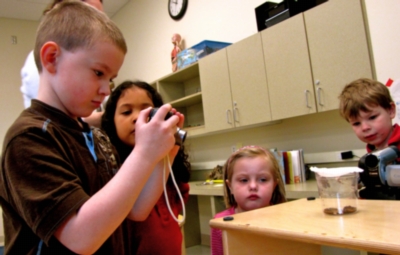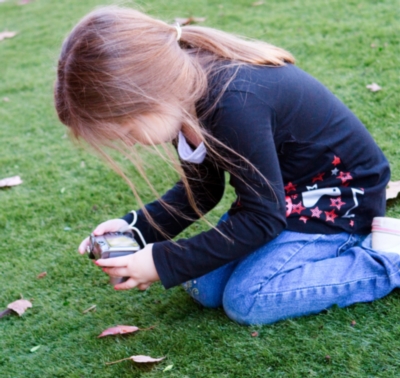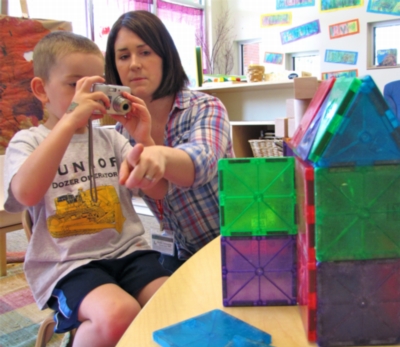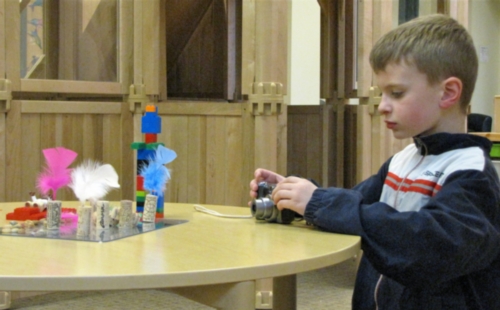Description
Another great tool that helps to encourage early learning in young children is the digital camera. Digital Cameras provide children with the opportunity to capture their world as an image/picture. They provide the ability to document their creative work, the activities of their peers, and objects or around them. They are a manipulative tool that engages and displays the power of a thousand words.

One approach to help children learn to use a digital camera is to begin with a simple lesson. Begin by teaching students how to: 1. handle and treat a camera with respect, 2. hold and take a photograph, 3. review the photographs in the camera, 4. download and store the photographs they have taken (with older students). Allow children to discover the joy of being able to capture and save an image for later use or to share with others .
Our preferred tool is an actual adult digital camera that is easy for small hands to grasp. It needs to have a screen large enough to be easily viewed and a big button making it easy to take the picture. Digital cameras can be used inside and outside of the classroom and can be hooked up to any computer to display the image for class discussion, story writing (Create and Dictate), or to post pictures on a blog or Webpage.
Suggestion for use
 Classroom: The intentional use of cameras in the classroom to document learning activities, capture interesting observations, or support literacy activities can take myriad forms. Here are some suggested activities:
Classroom: The intentional use of cameras in the classroom to document learning activities, capture interesting observations, or support literacy activities can take myriad forms. Here are some suggested activities:
- Photographing creative structures prior to clean up so that they can be “saved forever”, this can be extended into a later literacy activity.
- Students can document an event or learning activity such as special classroom visitor or field trip.
- Students photograph their artwork or writing and elaborate these digital documents extending their literacy skills.
 Outside: Digital cameras can be used outside by students to capture the natural world around them (on nature walks). The garden is a great place to photograph plants, flowers, insects and other animals.
Outside: Digital cameras can be used outside by students to capture the natural world around them (on nature walks). The garden is a great place to photograph plants, flowers, insects and other animals.
Nature walks:
Allow children to document and capture the things they see around them, from pine cones, leaves, to flowers, to squirrels, and each other. Imagine taking cameras on a walk to view a particular element of the natural world, and then reviewing students' photographs back in the classroom as a way to reflect on what was observed. Later those photographs could be printed out or digitally saved so that students could write or dictate a narrative about the activity.
Lesson Ideas
Storyography: Multimedia storymaking
 1. Children work on developing creative personal stories and utilize manipulative materials as a means of representing elements of their story. (Legos, magnetic blocks, animal/people figures, etc.)
1. Children work on developing creative personal stories and utilize manipulative materials as a means of representing elements of their story. (Legos, magnetic blocks, animal/people figures, etc.)
2. Use their words to describe to the teacher the details of the story (including characters, a problem, and a possible solution).
3. Use a digital camera (with the help of the teacher, when needed) to photograph each page of the story they have created.
4. The teacher then prints out the pictures and the words to the story. This allows the child to put together the story in a book format.
An alternative way to complete the story is through the use of the iPad app Story Kit Here is the above story using that application.
Documenting Change Over Time:
1. Find a plant or element of the natural world that you would like to document changing over time (eg. a garden)
2. Locate a spot that you will regularly use as the perspective on this change.
3. Take photographs ar regular intervals (eg, Fall, Winter, Spring, Summer).
4. Display the photographs and encourage students to describe the changes that have taken place in a manner that is developmentally appropriate.
Digital Scavenger Hunt:
1. Give digital cameras to students with the objective of locating and documenting specific images such as the letters of the alphabet or shapes occurring in the environment (triangles, circles), or maybe prepositions.
2. Students work in pairs or individually to search for the letters, shapes or other images and then .
3. Images are downloaded and organized on a document or in iPhoto to represent the organized images that were captured
Images of use
We have assembled a collection of students using the digital cameras, in documenting storyography work, on nature walks, and in the classroom. We hope that viewing these will give you and inspire some good ideas in utilizing the digital camera. Please send us more as you discover new uses for these empowering tools.





 Classroom: The intentional use of cameras in the classroom to document learning activities, capture interesting observations, or support literacy activities can take myriad forms. Here are some suggested activities:
Classroom: The intentional use of cameras in the classroom to document learning activities, capture interesting observations, or support literacy activities can take myriad forms. Here are some suggested activities: Outside: Digital cameras can be used outside by students to capture the natural world around them (on nature walks). The garden is a great place to photograph plants, flowers, insects and other animals.
Outside: Digital cameras can be used outside by students to capture the natural world around them (on nature walks). The garden is a great place to photograph plants, flowers, insects and other animals. 1.
1. 